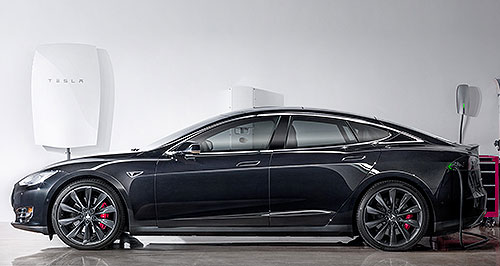News - TeslaTesla Powerwall to debut in Canberra in 2016Box of sparks: Tesla’s new offshoot, Tesla Energy, will start selling the Powerwall in the United States by the northern summer. Novel home back-up battery from Tesla to be rolled out in nation’s capital next year4 May 2015 By TIM ROBSON ELECTRIC vehicle-maker Tesla has announced a new offshoot, Tesla Energy, which is set to launch a lithium-ion battery pack for both home and commercial use. A Canberra energy start-up called Reposit Power, meanwhile, expects to be the among the first to offer the new units, as it extends its recently launched GridCredits solar storage program in the Australian Capital Territory with funding from the Australian Renewable Energy Agency. The Canberra company is currently accepting expressions of interest from potential customers on its website. Tesla’s Powerwall pack uses a lithium-ion battery array similar to the one used in the American company's car range. It’s designed not only to make the most of alternative power generation like solar and wind, but also to provide back-up power in the case of a blackout. It can also be used to supply off-grid power to homes at peak times, taking advantage of off-peak recharging to lower costs. Tesla Motors Australia marketing and communications manager Heath Walker said that the company was hoping to have the Powerwalls on sale by “Q1” of 2016. “The price is yet to be determined for this market,” he told GoAuto. “We are open to conversations with large organisations regarding commercial the battery storage (version).” Its initial pricing structure for the US will see the larger model sell to installers at US$3500 (A$4470), and the smaller at US$3000 (A$3830). The price does not include the AC/DC inverter required to safely convert the energy for appliance use, no does it include installation. In comparison, a commercially available Bosch 6.6kWh storage system retails in Australia for more than $30,000. “Our goal is to fundamentally change the way the world uses energy,” Tesla founder Elon Musk told a press conference at the Tesla Design Centre in California last week. “It sounds crazy, but we want to change the entire energy infrastructure of the world to zero carbon.” Two sizes are being offered initially a 10 kilowatt-hour (kWh) model designed for weekly cycling, and a smaller seven kWh version built for daily use. Up to nine units can be piggybacked together to build a bigger, stand-alone power source, according to Tesla. The typical Australian household uses an average of 18.1kWh a day, according to the Australian federal government’s Energy Made Easy website. A mid-sized (2kW) solar array can generate between 7kWh and 8kWh of energy, much of which is returned to the energy grid and re-sold to domestic users. The Australian GridCredit system allows solar panel users to maximise their profits automatically by selling excess power not stored in a back-up battery array, such as the Powerwall, back into the domestic grid at peak times, buying it when it's cheaper. The Powerwall is liquid-cooled and able to be mounted inside or outside. Its operating temperature range of -20 degrees Celsius to 43 degrees C may preclude it from being mounted in full-sun locations in Australia’s hotter cities. Running off 350 to 450 volts on a 5.8amp current, it outputs a claimed continuous 2.0kW, with a peak of 3.3kW. It can be installed on either a single or three-phase circuit.  Read more |
Click to shareTesla articlesResearch Tesla Motor industry news |

















Facebook Twitter Instagram